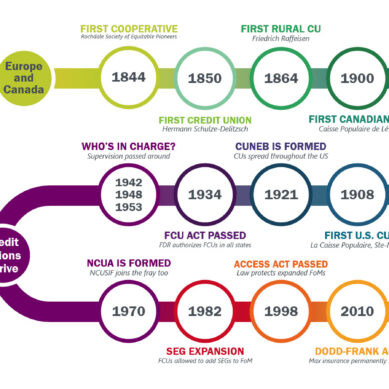How credit union partnerships can strengthen member experience and enhance impact
There’s no denying it—as industries mature, mergers and consolidation occur. Our credit union industry is no exception. Yet this has been a hot button issue in the credit union community, with many viewing consolidation as a sign that the industry is deteriorating. And the voices critical of mergers make compelling cases when pointing to statistics about merger activity far outpacing the number of new credit unions (dropping from 9,000 in the 1960s to just 21 from 2010-2017), thus accounting for the declining number of U.S. credit unions. Opponents tend to be particularly wary of combinations between large and small credit unions, drawing comparisons to a Pacman or David vs. Goliath dynamic where the small, scrappy credit union succumbs to the looming, behemoth credit union.
Not only do I disagree with this perspective, but I also feel this outlook detracts from the opportunity we have ahead. Mergers are not a symptom of weakness or stress in the system; mergers are—and will always be—a viable and powerful growth strategy. If a single industry is uniquely positioned to thrive through partnerships and mergers, I argue it is credit unions. Until credit unions have more than 10% of the market share, we are collaborators more than we are competitors. When we build partnerships intentionally, we can heighten each organizations’ collective impact and grow stronger traction behind the credit union movement as a whole.
So, how do we get there?
Cultural alignment
At Canvas Credit Union, we have experienced first-hand that strategic business partnerships can help elevate our industry. With the right alignments, if managed correctly, credit union partnerships can deliver strong benefits for all stakeholders. But it must start with shared values between both organizations.
The credit unions’ cultures should complement and reinforce each other. The teams must agree on the common goals, with all employees rowing in the same direction. At its core, a true partnership is built by human beings who are dedicated to enhancing their impact while embracing the notion that pooling the strengths of each organization will ultimately lead to stronger outcomes. Only if this alignment is in place can a partnership thrive. From here, strong benefits will flow.
People first, second and third
The most critical, yet often overlooked, step to ensure a partnership is primed to enhance impact is quite simple: listening. Successful mergers are born from listening intently to credit union stakeholders to uncover vision, culture and challenges. The needs for each market, each member segment and each internal division will differ. Listening closely to members, internal teams and community groups to collect input should ultimately guide the process. This is the magic step that will enable the partnership to deliver a tailored experience at all levels that is truly additive.
What can result from a merger built with a people-first approach is the ability to go deeper and wider in its impact for these very audiences. Forming partnerships to build credit unions with greater resources enables us to deepen our roots within each community, focus on local relationships and tailor expertise to better serve the nuances of each market. Ensuring leaders within both organizations understand the importance of these human issues, brings opportunity to invest back into these communities with greater philanthropic involvement, one of the key tenets behind the ‘credit union difference.’
Bolster resources
Members of smaller credit unions come for the familiar, personal and local experience. They stay for the quality service. However, the industry is seeing that many depart due to a lack of current technologies and competitive rates.
By aligning resources, smaller credit unions are better positioned to remain competitive for their members while navigating the high overhead expenses that have become the norm of today’s landscape. Increasing costs associated with technology, compliance needs and innovation efforts in order to meet evolving consumer expectations have led to market forces that are undeniably more challenging for smaller credit unions with fewer resources. The right partnerships can drive more robust products and services for members in ways that are simply inaccessible for smaller credit unions on their own.
Filene Research Institute presents evidence that mergers can provide value to credit union members, and the greatest benefits tend to occur when small and medium-sized credit unions merge with large credit unions, spurring better rates and a broader range of products and services. In fact, the research report found that small credit unions stood to see a 0.7% decrease in loan rates for members by merging with larger credit unions. Additionally, smaller credit unions saw a decreased cost per asset of 1.3%.
Expand opportunities
Nothing brings our industry leaders more pride than seeing professionals passionate about member experience rising through the ranks of credit unions. It is important to remember that our teams are trusting us with their most precious asset—their time. As the battle for talent reaches new heights across most industries, employee retention is paramount for credit unions to continue expanding and capitalizing on innovation through experience and exposure.
Strategic partnerships between credit unions can provide their respective teams with an expansive network of professional opportunities and a broader geographic footprint. This can mean the promotion of a spouse, the fluctuating real estate market or a need to be closer to an ailing loved one, does not have to necessitate a departure. Further, the broader internal credit union network allows for a wider array of opportunities and professional possibilities. These higher rates of professional retention also improve member experience as the credit union becomes more diverse, more experienced and better resourced.
When you peel back the layers behind this complex—and at times divisive—topic, I firmly believe that it boils down to one very important issue: heart. It is rare to come across industry leaders whose hearts are not on fire for their members. For most, we entered the credit union movement because we care so deeply about our members, colleagues and communities. As such, we continually search for any and every way to better serve these groups. I see vividly the ways mergers can help us do this.
There is no doubt that not all mergers will be successful. But when done in the right way, with the right intentions and with a people-first approach, these partnerships can be catalysts for a stronger, more competitive landscape for many years to come.
























































